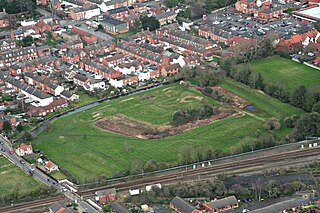
Sleaford is a market town and civil parish in the North Kesteven district of Lincolnshire, England. On the edge of the Fenlands, it is 11 miles north-east of Grantham, 16 mi (26 km) west of Boston, and 17 mi (27 km) south of Lincoln. It is the largest settlement in North Kesteven with a population of 19,807 in 2021. Centred on the former parish of New Sleaford, the modern boundaries and urban area include Quarrington to the south-west, Holdingham to the north-west and Old Sleaford to the east. The town is bypassed by the A17 and the A15 roads, which link it to Lincoln, Newark, Peterborough, Grantham, Boston and King's Lynn. Sleaford railway station is on the Nottingham to Skegness and Peterborough to Lincoln lines.

Howell is a village in the civil parish of Asgarby and Howell, in the North Kesteven district of Lincolnshire, England, approximately 1 mile (1.6 km) north of the A17, 4 miles (6 km) east from Sleaford, and 1.5 miles (2.4 km) north from Heckington. In 1921 the parish had a population of 58.

Capon Chapel, also historically known as Capon Baptist Chapel and Capon Chapel Church, is a mid-19th century United Methodist church located near to the town of Capon Bridge, West Virginia, in the United States. Capon Chapel is one of the oldest existing log churches in Hampshire County, along with Mount Bethel Church and Old Pine Church.
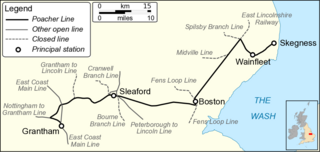
The Grantham–Skegness line, promoted originally as the Poacher Line, runs for 55 miles (89 km) between Grantham and Skegness in Lincolnshire, England. Trains on this route generally operate hourly from Nottingham to Skegness via the Nottingham to Grantham Line, with additional slower stopping services at peak times. The line is operated by East Midlands Railway, using Class 170 Turbostar and Class 158 Express Sprinter diesel multiple units.
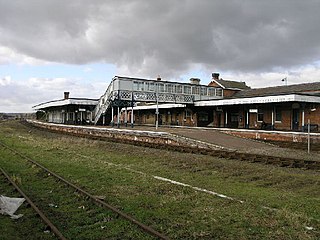
Sleaford railway station serves the town of Sleaford in Lincolnshire, England. It lies on the Peterborough–Lincoln line. The station is 21 miles (34 km) south of Lincoln Central.

Heckington railway station is located in the village of Heckington in Lincolnshire, England. The old station building houses the Heckington Station Railway and Heritage Museum.
Heckington is a village and civil parish in the North Kesteven district of Lincolnshire, England. It is situated between Sleaford and Swineshead Bridge, and south of the A17 road. Heckington, with 1,491 households, is one of the largest villages in Lincolnshire. The population of the civil parish including Boughton was 3,353 at the 2011 census.
The new Christian denomination of Methodists was formed in the early 18th century as a breakaway movement from the established Church of England. It was mainly formed by two Church of England ministers, John Wesley, the preacher and his brother, Charles Wesley, the hymn writer. The Methodist Church has had a following in Ripley from the formation of the earliest church up to the present day.

Albert Edward Lambert FRIBA was an architect based in Nottingham, England.
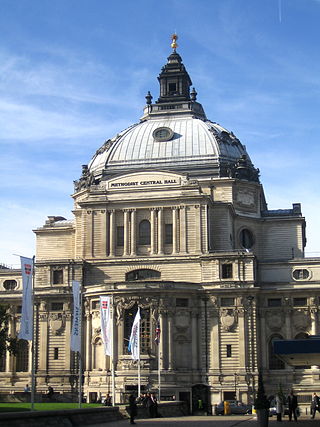
The organisation of the Methodist Church of Great Britain is based on the principle of connexionalism. This means that British Methodism, from its inception under John Wesley (1703–1791), has always laid strong emphasis on mutual support, in terms of ministry, mission and finance, of one local congregation for another. No singular church community has ever been seen in isolation either from its immediately neighbouring church communities or from the centralised national organisation. Wesley himself journeyed around the country, preaching and establishing local worshipping communities, called "societies", often under lay leadership. Soon these local communities of worshipping Christians formalised their relationships with neighbouring Methodist communities to create "circuits", and the circuits and societies contained within them, were from the very beginning 'connected' to the centre and Methodism's governing body, the annual Conference. Today, societies are better known as local churches, although the concept of a community of worshipping Christians tied to a particular location, and subdivided into smaller cell groups called "classes", remains essentially based on Wesley's societies.
Richard Charles Sutton was an architect based in Nottingham. He was born 1834 and died on 18 October 1915.
South Kyme is a small village and civil parish in the North Kesteven district of Lincolnshire, England. The population of the civil parish at the 2011 census was 393. It is located 2.5 miles (4 km) south-east from North Kyme which is itself 2.5 miles (4 km) from Billinghay.
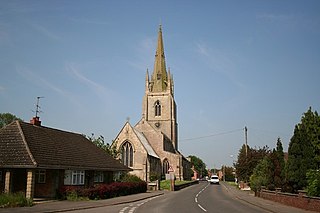
Helpringham is a village and civil parish in the North Kesteven district of Lincolnshire, England. It lies on the edge of the Fens, and 5 miles (8 km) southeast of Sleaford. It is noted for its Grade I listed St Andrew's Church.

The former Central Methodist Church was until 2018 the main Methodist place of worship in Eastbourne, a town and borough in the English county of East Sussex. The large town-centre building, with attached schoolrooms and ancillary buildings, was the successor to earlier Methodist places of worship in the area. Soldiers brought the denomination to the area in 1803, when an isolated collection of clifftop villages stood where the 19th-century resort town of Eastbourne developed. A society they formed in that year to encourage Methodism's growth and outreach survives. Local Methodist worshipper and historian Carlos Crisford designed the lavish church in 1907, and it has been used for worship ever since—even as several other Methodist churches in the town and surrounding villages have declined and closed. For several years until 2013, it also housed a Baptist congregation displaced from their own church building. Central Methodist Church is a Grade II listed building.
The Handleys were a prominent family in Sleaford, Lincolnshire, between around 1777 and the late 1800s. An offshoot of the notable Newark family, the Handleys of Sleaford came to hold position as lawyers, bankers, politicians and clerics in the town and attained great wealth and holdings in the area. The family maintained an interest in transportation - first in canalisation and later the development of the railways.
William Herbert Higginbottom JP was an architect based in Nottingham.

Underhill Methodist Church is a Methodist Church, opened in 1899, located in Fortuneswell, on the Isle of Portland, Dorset. It was built between 1898 and 1899, replacing a 1793 chapel built by Robert Carr Brackenbury, the founder of Methodism on Portland. The church remains active to date, as part of the Portland Methodist Circuit, alongside Easton Methodist Church.

Abraham Harrison Goodall LRIBA was a British architect based in Nottingham.

Broadwey Methodist Church is a Methodist church in Broadwey, Weymouth, Dorset, England. It was built in 1928 and was active as part of the Dorset South & West Methodist Circuit until 2021.














